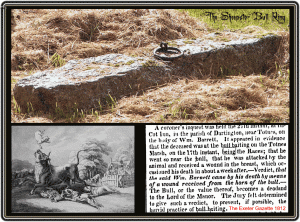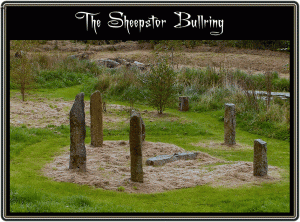
In the August of 1908 Amos Shillibeer was ploughing one of his fields when the point of one of the plough shares became caught in a large metal ring which was buried in the soil. Some forty years later the Rev. Hugh Breton and Amos’ son George went to the field to investigate what had brought the ploughing operation to such an abrupt halt. After a prolonged search with the help of crowbars the pair eventually came across the ring buried beneath the turf. It was then discovered that the ring was attached to a five foot long granite block which was then raised to the surface.
What the couple had discovered was a barbaric relic of days gone by in the form of a bull baiting post. At one time it was considered sport to tether a bull to the ring and then set dogs onto it, tradition has it that any dogs that were gored to death in the fray would be buried under the granite block. As far as I know there has been no discovery of dog bones anywhere near the bull ring? Such events were well attended by locals and visitors alike who would sit on the churchyard wall to watch the ‘sport’. Every now and again members of the ‘audience’ would retire to the nearby ale house for a jug or two of cider or beer. Again tradition has it that the women would wear large aprons in which they would catch any of the dogs unfortunate enough to be tossed airborne by the bull. Breton, pp. 29 – 30.
The dogs used in bull baiting were normally Bull Dogs (hence the breed’s name) and were specially bred for this purpose. Once the bull had been tethered to the bull ring the dogs would be set loose on the poor creature. Their method of attack was to flatten itself as close as possible to the ground and then slowly creep towards the bull. When it came withing striking distance it would launch itself at the bull in an attempt to bite the animal on it’s nose or throat. One of the main attributes of the breed was their ability to inflict a powerful bite which once the jaws were locked was hard to dislodge. As the dogs attacked the bull they would often be tossed or gored into the air and as mentioned above the local women would then try to catch the dogs in their aprons. Clearly to get an exciting contest the bull needed to be angry and amongst other methods of doing this was to blow pepper up its nostrils. Should the bull fall to the ground out of exhaustion it had been known to light a small fire under its belly in order to get it to stand up and continue the struggle. One very strange concept that still exists today is that meat from any animal that has subjected to high stress levels produces a tastier meat when slaughtered due to the adrenaline being in its body at the time of death. It is suggested that the adrenaline has a tenderising effect on the meat?
Sheepstor was not the only venue where bull baiting would take place on Dartmoor as Ashburton with it’s bull-ring will testify. Whilst I can find no documented evidence of such event taking place on the moor there is an interesting one from a bull baiting fight at Exeter in the late 1700s written by a woman spectator. She commented that; “The bull was in fine vigour and action. The streets were filled with an immense multitude of people. The windows were decorated with some of the finest faces and most elegantly dressed women I had seen for some time – all to see the bull baiting.” She further added that on the fourth attack by the dogs the bull was held upon which a loud cheer went up from the mob and some of the ‘genteelist‘ of women were seen to be enthusiastically applauding the dogs. At this point of the proceedings the bull was un-tethered and immediately went for the crowd who all scattered in panic. Occasionally the poor bull had his revenge as can be seen from a report in the Exeter Gazette from 1812 (see above). In this instant a gentleman spectator at Totnes got too close to the bull and was gored in the chest by its horns and sadly died a week later from his wounds. It is also interesting to note that the bull or its value became deodand (an old law which stated any object or instrument that caused the death of a person was forfeited) in this case to the lord of the manor. Another report from Exeter appeared in the Western Times in 1833 read as follows; “The admirers of the classical sport of Bull Baiting had a grand field day at Countess Wear, on Monday last. Notice was posted at Govier’s blacksmith shop on the Topsham road, that a ‘fine young grass bull’ would be had for the occasion, but it turned out to be a hoax, as the unfortunate animal was the same, it is said, as was baited about two years ago in St. Sidwells. It is a rather small bull, and belongs to a man at Upton Pyne who, it is stated, lets it out for this barbarous sport at 30 shillings a day. The bull being an old hand made very light of the matter, and the dogs being unable to pin him, the sport was continued until dusk, many of the dogs being severely punished, about 2,000 persons were present, and amongst them the soi disant (self styled) Sir William Courtnay. There was also a very clever London Artist present, who has made a sketch of the scene, and we shall probably see a glaring caricature of the whole – the secretary drinking heavily from a delf pot, along with a group of jovial sailors.”
In 1800 Sir William Pultney tried to introduce a bill banning the baiting of bulls with dogs but despite being fiercely debated he lost the day by a mere two votes. The then Prime Minister, George Canning, had argued in favour of the sport saying that; “the amusement inspired courage and produced a nobleness of sentiment and elevation of mind.” In 1822 an act to ‘Prevent the Cruel Treatment of Cattle’ was passed and some magistrates took this to include bull baiting. However in 1827 the King’s Bench declared that the bull was not referred to in the bill and that they were not included in the genus ‘cattle’. It was not until the ‘Cruelty to Animals’ act of 1835 was passed that bull baiting and other such ‘sports’ which involved the baiting of animals was made illegal. Unfortunately no matter what laws are passed there are always those that will disregard them and there are cases of people getting fined between 5 and 10 shillings for participating in bull baiting several years after the introduction of the act.
Just one aside to this, in his book – The Virgin in Judgement Eden Phillpotts uses the bull-ring field as the location for a prize fight between David Bowden (from Ditsworthy Warren) and Bartley Crocker (a Sheepstor smallholder). Having said that the Rev. Hugh Breton noted that to the best of his knowledge no such fights ever took place at or near the bull-ring, p.30.
“The bull-ring of Sheepstor is a grassy field of near an acre in extent, surrounded west and east with beech trees, hemmed by a road and a little river southward and flanked by the churchyard wall on the north. Here bull-baiting, cock fighting, cock shying, and other rough sports of our great-grandfathers were enjoyed; and here, on this winter morning one of the last authentic prize-fights ever fought in England was duly conducted with all the right ritual, pomp and circumstance…“, p.103.
Please note: The Sheepstor Bull Ring is located on private property although there have been opportunities to visit it when the Sheepstor Open Garden Event takes place.

Breton, H. 1990. Beautiful Dartmoor. Liverton: Forest Publishing.
Phillpotts, E. 1908. The Virgin in Judgement. London: Cassell & Company, Ltd.
 Legendary Dartmoor The many aspects past and present of Dartmoor
Legendary Dartmoor The many aspects past and present of Dartmoor



Interesting post Tim. We often browse the legendary Dartmoor site, after walking on the moors. It’s a great resource.
This is truly helpful, thanks.